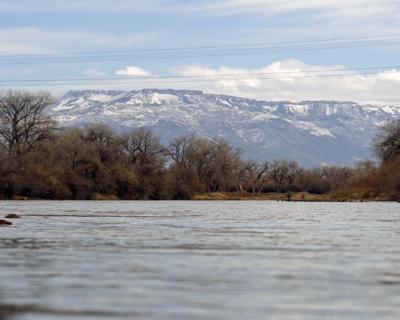Continuing snowstorms throughout much of this winter are now making it likely that Colorado will enjoy a decent runoff season this spring, and it could be even better than that should the current moisture trends continue in coming months.
About a month out from when snowpack levels at mountain measurement sites typically peak in Colorado, levels in some river basins, including the Gunnison basin, already have exceeded those peaks. And the snow keeps coming.
“The next week is looking really promising in terms of snowfall for the high elevations. It’s likely to improve runoff forecasts even from where they are now for the most part,” Peter Goble, a climatologist for the Colorado Climate Center at Colorado State University, said Friday.
Spring runoff is crucial for supplying agricultural, municipal and other water uses in Colorado and downstream states.
As of Friday, statewide snowpack, which is a measure of snow water equivalent that accounts for the amount of water in the snow that has fallen, was at 120% of the 1991-2020 median, according to data from Natural Resources Conservation Service measurement sites.
The Gunnison basin’s snowpack is at 135% of normal, and the level for southwest Colorado’s combined San Miguel/Dolores/Animas/San Miguel basins is 136% of normal. The Yampa/White river basins are at 134% and the Upper Colorado River Basin in the state is at 118%. The Arkansas River Basin is the only major basin in the state with below-normal snowpack, but it’s considerably below normal, at just 72%.
Locally, snowpack at measurement sites on Grand Mesa range from 120% of normal at Mesa Lakes to 161% of normal at Park Reservoir. Columbine Pass on the Uncompahgre Plateau is swimming in snow, with levels just shy of twice the normal.
The Gunnison River Basin already is at 102% of its seasonal median peak snowpack, normally reached about another 30 days from now. The Yampa/White basins are at 113% of median peak. The Upper Colorado River basin in the state is at 94% of median peak, and the San Miguel/Dolores/Animas/San Miguel basins are at 121%.
NRCS hydrologist Karl Wetlaufer said in a news release, “This is an encouraging place to be from a water supply standpoint for these portions of the state that have had several years of below normal streamflow runoff.”
Said Goble, “With the amount of snowpack we have on the hills now I think we’ve got at least a decent runoff in the bag.”
He said this likely will be the best runoff season since 2019. He said it’s still possible for runoff to be slightly below-normal if snowfall drops well below-normal later this month and into April and May, but if that period is wet runoff could end up way above normal.
While dry soils going into recent winters have resulted in the soil soaking up a good amount of the snowmelt before it reaches streams during spring runoff, Goble is encouraged by the fact that summer and fall moisture last year boosted soil moisture levels.
“With that and a robust-looking snowpack we’re feeling hopeful right now” for good runoff, he said.
The NRCS said in its monthly Water Supply Outlook Report for Colorado on March 1 that streamflow forecasts for the April-July runoff season run stood at 155% of normal for the Yampa/White basins, 130% for the Gunnison basin and 107% in the Colorado River headwaters. Runoff at Surface Creek in Cedaredge is projected to be 173% of median, and in the upper North Fork of the Gunnison it is projected to amount to be nearly 160% of median.
While reservoir storage levels are averaging about normal for this time of year in the Colorado River headwaters, the Gunnison basin is at just 69% of normal thanks in good part to low levels in Blue Mesa Reservoir, the state’s largest water body. Goble said he thinks it would take two wet winters rather than just one to refill that reservoir, though he noted that the reservoir completely refilled in 2019 thanks to heavy snow despite being low the previous year.
But he said refilling the two large reservoirs downstream of Colorado, Lake Powell and Lake Mead, would require a number of good snowpack years in the Colorado River Basin rather than just one or two.














